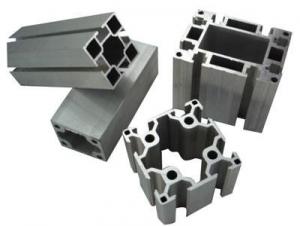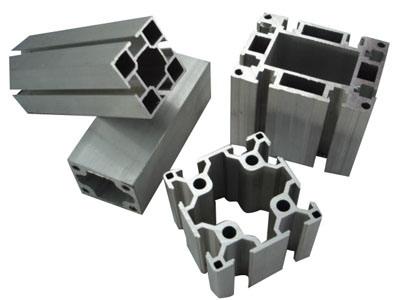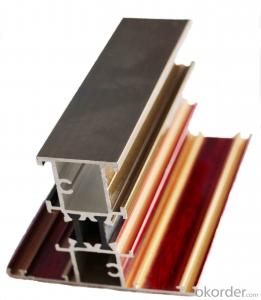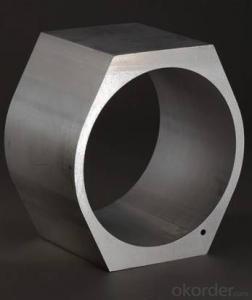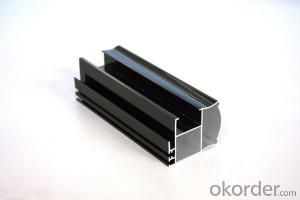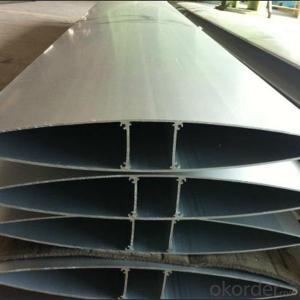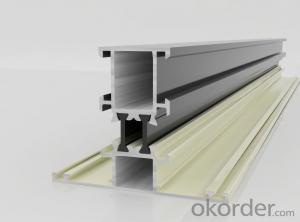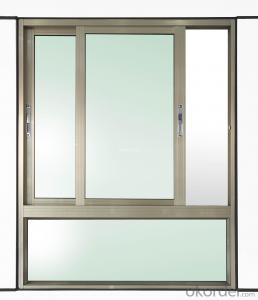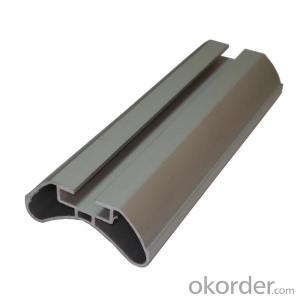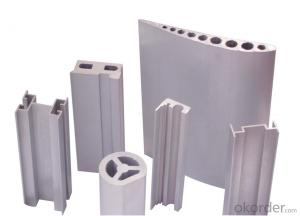Fath Aluminum Profiles - Aluminum Profile-AA6061
- Loading Port:
- China Main Port
- Payment Terms:
- TT OR LC
- Min Order Qty:
- -
- Supply Capability:
- -
OKorder Service Pledge
OKorder Financial Service
You Might Also Like
1)Material : 6063 6061 6060 and different aluminium alloy
2)Status:T4 T5 T6 or other special status
3)Surface treatment: mill finish, anodized sliver ,anodized bronze, anodized champagne, anodized black pearl, various power coating color, electrostatic sliver, electrostatic champagne, electrostatic golden, electrostatic titanium , machine polish sliver, machine polish bronze, wooden grain color, and Fluorocarbon spraying.
4)Annual capacity : 80000TON
5)Quality : China Nation Standard GB/T 5237 2004 (advanced class)
6)Use: can be widely using aluminium window, door, curtain wall, hand railing , normal aluminium profile, decorative and industrial aluminium profile
- Q: This question asks for a description of the various forms and dimensions of aluminum profiles that are typically utilized in the construction industry.
- <p>Aluminum profiles used in construction come in various shapes and sizes to cater to different structural needs. Common shapes include angles, channels, I-beams, H-beams, T-profiles, and rectangular or square tubes. Sizes vary based on the thickness of the aluminum and the dimensions of the profile, such as width, height, and length. For instance, an H-beam might have a depth ranging from 100mm to 900mm and a width from 50mm to 300mm. The selection of the right profile depends on the specific requirements of the construction project, such as load-bearing capacity, aesthetic considerations, and cost efficiency.</p>
- Q: What are the different fastening options available for aluminum profiles?
- Some of the different fastening options available for aluminum profiles include screws, bolts, nuts, rivets, and adhesive bonding.
- Q: Tips for identifying aluminum profiles
- Of course, you can also put the same type of profiles in a comparison, of course, if the color is too obvious, super good to buy. Check whether the thickness of the aluminum profile is the same as the model marked.After the ultra hard material, smooth surface can be used to draw the profile, leaving a white scratch, aluminum gently wipe and observe, if cannot be erased, indicating the material may have quality problems, but instead if you can easily wipe that film thickness of material surface is qualified.
- Q: This question asks about the various types of surface treatments or finishes that can be applied to aluminum profiles.
- <p>Aluminum profiles can be coated with different types of finishes to enhance their appearance, durability, and resistance to corrosion. Some common types of coatings include: 1. Anodizing, which creates a protective oxide layer on the surface. 2. Powder coating, a durable and colorful finish applied through an electrostatic process. 3. Electrophoretic coating, a method that uses electric current to apply a paint-like coating. 4. PVDF coating, a high-performance finish with excellent weather resistance. 5. Thermal spraying, which applies a coating through a high-velocity flame. 6. Vacuum coating, a process that deposits thin layers of material in a vacuum chamber. Each type of coating has specific properties and applications, making them suitable for different environments and uses.</p>
- Q: Are aluminum profiles resistant to impact?
- Aluminum profiles are typically able to withstand impact, making them a reliable choice. Aluminum is renowned for its impressive strength-to-weight ratio, which means it is both robust and lightweight. This feature makes it ideal for situations where impact resistance is crucial, like in construction where it is utilized for window frames, doors, and curtain walls. Moreover, aluminum profiles can be strengthened further by applying different surface treatments and coatings to enhance their impact resistance. Nevertheless, it is important to acknowledge that the impact resistance of an aluminum profile may differ based on factors such as thickness, design, and any supplementary reinforcements employed.
- Q: What are the different methods of joining aluminum profiles together?
- There are various ways to connect aluminum profiles, depending on the desired result and specific application. The most commonly used techniques include: 1. Mechanical fastening: To secure aluminum profiles, screws, bolts, or rivets can be employed. This method is straightforward and cost-effective, suitable for different applications. However, it may leave visible fasteners and require additional finishing. 2. Welding: Aluminum profiles can be joined using different welding techniques like TIG, MIG, or laser welding. Welding creates a sturdy and seamless joint, making it ideal for structural purposes. However, it demands specialized equipment and expertise. 3. Adhesive bonding: Specialized adhesives for aluminum bonding can be utilized to connect profiles. This technique offers high strength, even stress distribution, and a clean appearance. Adhesive bonding is commonly used for lightweight applications or when welding is not feasible. 4. Slotting and interlocking: Profiles with specially designed slots or interlocking features can be connected without additional hardware. This method ensures a seamless and neat appearance while maintaining structural integrity. 5. Thermal joining: Heat-based methods like hot plate welding or induction heating can be employed to connect aluminum profiles. These processes involve melting a portion of the aluminum surface and bonding it upon cooling. Thermal joining provides both strength and aesthetics without requiring extra materials. 6. Extrusion-based connectors: Connectors designed for extrusion are components that allow for the joining of aluminum profiles. These connectors are typically inserted into the slots or channels of the profiles, providing a secure and long-lasting connection. When choosing the appropriate method for joining aluminum profiles, it is necessary to consider factors such as strength requirements, appearance, ease of assembly, and cost. Each method has its own advantages and limitations, so the most suitable technique depends on the specific application and desired outcome.
- Q: Inquire about the various uses of aluminum profiles within the field of architecture.
- <p>Aluminum profiles have a wide range of applications in architecture due to their strength, durability, and lightweight properties. They are commonly used in curtain walls, which are the exterior coverings of buildings, providing both aesthetic appeal and structural integrity. Aluminum profiles are also utilized in window and door frames for their resistance to corrosion and ability to withstand various weather conditions. They are employed in structural glazing to hold glass in place securely. Furthermore, aluminum profiles are used in sun shading systems to control the amount of sunlight entering a building, enhancing energy efficiency. They are also found in handrails, balustrades, and other safety features for their strength and low maintenance requirements. Overall, aluminum profiles contribute to the sustainability and modern design of architectural projects.</p>
- Q: This question asks for a description of the various dimensions and forms of aluminum profiles that are utilized in siding systems.
- <p>Aluminum profiles for siding systems come in a variety of sizes and shapes to accommodate different architectural styles and structural requirements. Common profiles include flat bars, channels, angles, and Z-profiles. Sizes can range from narrow trims of 10mm to wide panels of over 200mm in width, with thicknesses typically from 0.5mm to 3mm. Shapes are designed for specific functions, such as interlocking for a seamless appearance, or with grooves for attaching insulation. Custom profiles are also available for unique applications. These profiles are chosen based on the building's design, load-bearing needs, and aesthetic preferences.</p>
- Q: What are the different surface protection methods for aluminum profiles?
- There are several different surface protection methods available for aluminum profiles, each offering unique benefits and protection against various environmental factors. Some of the most common surface protection methods for aluminum profiles include anodizing, powder coating, and liquid coating. Anodizing is a popular surface treatment for aluminum profiles as it provides excellent corrosion resistance and enhances the appearance of the metal. This process involves immersing the aluminum profile in an electrolyte solution and applying an electric current to create an oxide layer on the surface. Anodizing can be carried out in various colors, allowing for customization and aesthetic appeal. Powder coating is another widely used method for protecting aluminum profiles. In this process, a dry powder is electrostatically applied to the surface of the metal and then cured in an oven. The powder melts and creates a durable, protective layer that offers resistance against scratches, UV rays, and chemicals. Powder coating is available in a wide range of colors and finishes, providing both protection and aesthetic options. Liquid coating, such as liquid paint or lacquer, can also be applied to aluminum profiles to provide protection against corrosion and other environmental factors. Liquid coatings offer versatility in terms of color and finishes, allowing for customization and meeting specific design requirements. However, compared to anodizing or powder coating, liquid coatings may be less durable and require more maintenance over time. Additionally, there are other surface protection methods for aluminum profiles, such as mechanical finishing techniques like brushing or polishing. These methods help to remove imperfections and create a smooth, visually appealing surface. In conclusion, the different surface protection methods for aluminum profiles include anodizing, powder coating, liquid coating, and mechanical finishing techniques. Each method offers distinct advantages in terms of corrosion resistance, durability, aesthetics, and customization options. The choice of surface protection method ultimately depends on the specific requirements, budget, and desired appearance of the aluminum profiles.
- Q: Can aluminum profiles be used for medical equipment or devices?
- Yes, aluminum profiles can be used for medical equipment or devices. Aluminum is a widely used material in the medical industry due to its unique properties. It is lightweight, yet strong and durable, making it suitable for various medical applications. Aluminum profiles can be used to manufacture medical equipment such as hospital beds, wheelchairs, surgical tables, and diagnostic equipment. The corrosion resistance of aluminum also makes it ideal for medical devices that come in contact with bodily fluids or chemicals. Additionally, aluminum is easily sterilizable, which is crucial for maintaining a hygienic environment in healthcare settings. Overall, aluminum profiles offer numerous advantages for medical equipment and devices, making them a popular choice in the medical industry.
Send your message to us
Fath Aluminum Profiles - Aluminum Profile-AA6061
- Loading Port:
- China Main Port
- Payment Terms:
- TT OR LC
- Min Order Qty:
- -
- Supply Capability:
- -
OKorder Service Pledge
OKorder Financial Service
Similar products
Hot products
Hot Searches
Related keywords
